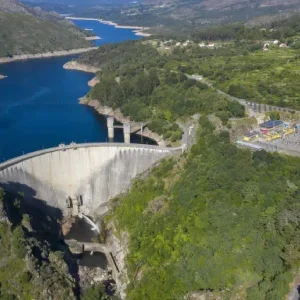As long ago as 1992, the European Wind Energy Association (EWEA) calculated that the development of wind energy on a European basis at a responsible rate would yield 4000 MWe by the year 2000. In the event, by the end of 1998, over 6300 MWe had been installed, and EWEA had to double its estimate to 8000 MWe by 2000.
Other new EWEA targets are as follows:
40 000 MWe by 2010;
100 000 MWe by 2020.
The world market demand for wind power has grown dramatically. In 1990, annual demand was at 200 MWe/year; by 1995, demand was at 1300 MWe/year. This trend will continue, and it is estimated that demand will be 2500 MWe/year by 2000.
Over the last five years, European wind turbine manufacturers have dominated the market. Of the 1292 wind turbine installations existing in 1996, over 80 per cent were supplied by European manufacturers.
Historical background
Modern wind energy use began in the late 1970s in response to the oil crises of 1973 and 1979. Both government sponsored programmes and private sector activity sprang up. Several different approaches were adopted. Some countries put considerable capital and effort into large R&D programmes, while others concentrated on creating the right market conditions for the deployment of the technology.
The first significant commercial market to appear was in California during 1980 to 1986. About 15 000 wind turbines were installed in California during the 1980s. During this period, the size of the average wind turbine generator increased from 55 kWe to 100 kWe.
There was a sudden decline in the California market between 1986 and 1990. The collapse of this market caused a number of problems for wind turbine manufacturers, and the number of manufacturers and the number of design concepts fell sharply. The standard Danish design of a 3-bladed, upwind, stall-regulated machine was optimised and upscaled to 250 kWe, making turbines more cost-effective. Large pitch regulated wind turbines were also designed and manufactured. These technical developments made it economically feasible to install wind power in many new markets and initiated the second period of wind power development.
Since 1990, the size of turbines has risen dramatically, with volume production of medium size machines in the 600 kWe range, and about 10 designs with commercial prospects in the 1 MWe range.
Preparing to go offshore
Recently wind turbine sizes have been rising even further. This is timely as the industry prepares for major offshore developments. Full exploitation of wind potential will require optimised machines for different types of site.
High and low wind speed;
Onshore and offshore;
Remote and grid connected;
Large and small applications.
Cost trends show the latest megawatt machines as competitive. It is important to assess up-scaling limits and the need for new concepts for large offshore units. Major offshore developments are certain early next century, and will be the next technological step.
Resource capacity
To put wind energy technology into its proper context, it is important to have an estimate of wind energy’s strategic potential.
Two studies on resource capacity which used different assumptions came up with different results. Wijk and Coelingh used conservative assumptions, with a required mean wind speed of greater than 5.1 m/s, and only 4 per cent of land was useable. It concluded that the approximate world total of wind capacity was 20 000 TWh/annum. Grubb and Meyer considered wind speeds of 4-5 m/s as viable, which gave an approximate total capacity of 50 000 TWh/annum.
Economic perspective
No single value can be applied to the price of wind energy. Energy prices depend on wind speeds and on institutional factors, and have two principal components: capital repayments; and operating costs.
The cost of wind energy has fallen substantially over the last 15 years, while the ‘most economic size’ of machine has increased. The larger the machine, the fewer are required for a given capacity, bringing savings in site and O&M costs. Site costs can be reduced by 25 per cent buy moving from 300 kWe machines to 1 MWe machines.
Data from the European Renewable Energy Study indicate that wind may become one of the cheapest renewable energy sources.
Trends for the future
There are a number of trends that wind power has been following. These look set to continue – larger, more cost-effective machines operating in an increasingly environmentally aware market, with more and more markets becoming accessible.
If this trend does continue, then wind power has a great deal of potential. The next steps are towards offshore plants, with several such schemes in progress.
TablesTable 1: Annual installations and the European share






